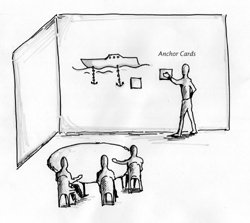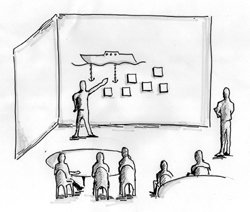Processing the Results
Playing the GameAfter the facilitator introduces the game, give customers a few minutes to gather their thoughts before you expect them to create anchors. Then, to help get the process of posting the anchors to the wall started, the facilitator should gently ask a few customers for completed anchor cards and tape these to the wall on behalf of the customer. After this is done, other customers will spontaneously join in and add anchors. There is no requirement that customers take turns posting anchors. In fact, the game works better if several customers and the facilitator are posting anchors at the same time because there is a formal review process. Figure 2.25. Posting Anchor CardsParticipants walk up to the wall, add their anchors, and return to their seats.
When customers have finished posting anchors, the facilitator begins the review process (see Figure 2.26). Try to review every single anchor. This lets your customers know that their feedback is important. The approach that works best is to let customers finish adding anchors, and then ask them to be seated. Walk up to the anchors and review each one. Although only one customer created the anchor, invite the whole group to comment on what was written. As you review the anchor, it is critically important that you refrain from trying to solve the problem, respond to the feedback, or justify why a certain choice is made. Doing this will dramatically change the game dynamic. Instead of encouraging forthright and sincere discussions of perceived problems, customers will interpret your response as a defense mechanism and will quickly become guarded in their communication and cynical of the process. Seek to understand the underlying reason why this anchor is holding them back from success, not in responding to or justifying the status quo. Figure 2.26. Reviewing the Anchor CardsFacilitator reviews each card with the customers. Observers keep track of what was said. There are practical reasons why you should not attempt to address or respond to anchors during the game. You probably don't have all the data needed to make a thorough response. You probably don't have all the necessary decision makers in the same room. You are almost certainly violating your product development and product management practices by making decisions in this manner. Perhaps most seriously, you're probably not in the right frame of mind to address these concerns, and you don't want to let the stress you may feel during this game result in short-sighted decisions. Note that reviewing every single anchor doesn't necessarily mean reading or sharing each anchor. Sometimes it is better to quickly group anchors with similar content and/or themes and talk about these anchors as a group. This means that you need to continually scan the anchors that are being added during the game to see if there are obvious trends. In rare cases, you can move anchors that customers have added to start the process of group formation during the exercise. The spatial arrangement of the anchors usually has important meanings to the participants. One example has already been mentionedgrouping similar cards. Sometimes customers will naturally put "heavier" or "larger" anchors near the bottom, or designate that there is more than one boat, where different boats have different meanings. To preserve the spatial memory of the exercise, take many photos during the game. Always take photos of the final card arrangement. Consider asking customers to vote on the top three or five anchors whose removal would have the most positive impact on the boat's speed. One variant that can be useful is to ask customers to add "engines" to the boats after they've finished. The engines represent features that can "overpower" the anchors and enable the boat to move faster. Do this carefully, because it changes the focus and dynamics of the game. If you really think that you need to focus on adding features, consider Product Box, Buy a Feature, or Prune the Product Tree. Sometimes, however, the energy of the room changes and the participants naturally start talking about adding features. When this happens, go with the flow and add some horsepower to your boats. |
EAN: 2147483647
Pages: 144

